Grid Project:
Barrow Ice Wedge Watershed Region
"lobster extended"
V3.C.1.1 (fine scale)
| Grid Team Member: |
Lucia Short |
| Grid Version: |
Version 03.C.1: multiple polygons
#6, 8, 9, 19, 21, 25, 27, 29, 31, 34, 35, 36, 37, 39, 45, 47, 50, 56 |
| Data Source: |
LiDAR data Area C from Chandana Gangodagamage |
| Delivered To: |
Scott Painter |
| Date Completed: |
September 26, 2013 |
| |
|
| V3.C.1.1 Mesh (6 layers): |
5,622,993 Nodes and |
11,034,624 Cells |
| V3.C.1 Mesh (6 layers): |
5,242,753 Nodes and |
10,285,056 Cells |
| V3.C.0 Mesh (6 layers): |
16,970,053 Nodes and |
33,441,792 Cells |
| V3.1 Mesh (6 layers) : |
1,404,657 Nodes and |
2,740,224 Cells |
| V3 Mesh (6 layers) : |
311,273 Nodes and |
602,112 Cells |
| V2 Mesh (5 layers) : |
311,273 Nodes and |
602,112 Cells |
| V1 Mesh (prototype): |
51,344 Nodes and |
94,080 Cells |
Purpose of Project
These meshes were developed in support of the Arctic Next Generation Ecosystem Experiment (NGEE-Arctic) Project and LANL Laboratory Directed project LDRD20120068DR. These two projects share a need for high quality computational meshes for use in fine-scale modeling of thermal hydrology in ice-wedge polygon landscapes.
Version 3.C.1.1 runs the Version 3.C.1 "lobster" adding polygon #56. This mesh is 3D based on multiple polygons ##6, 8, 9, 19, 21, 25, 27, 29, 31, 34, 35, 36, 37, 39, 45, 47, 50, 56 generated using LiDAR data set (area C). This mesh follows the criteria listed in the Mesh Input Parameters below. The mesh has 1 moss layer, 2 organic layers, and 3 mineral layers with a flat bottom. The Ice Wedge starts at the top of the mineral layers and is aprox 2.8 meters long. The convention of layer order numbering is from top to bottom. Two Exodus II mesh files are written, one multi-material with ice, and one single material.
The layers above ice have a constant thickness throughout the mesh. The bottom layers (mineral 5 and 6) have variable thickness where ice material replaces mineral material.
Changes in Files
This version doesn't have any changes besides the different set of polygons.
Full Stacked Mesh with Ice Wedge
6 material layers plus ice material
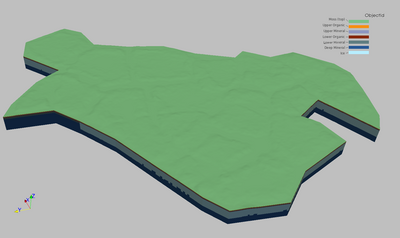 |
Full Stacked Mesh with Ice Wedge
Cut to show internal materials
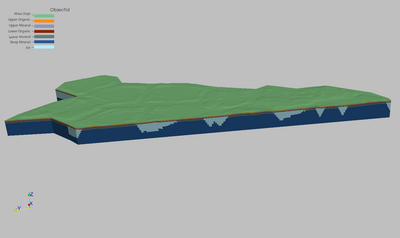 |
Mesh and Ice Wedge
with moss and organic layers removed
 |
Ice Wedge
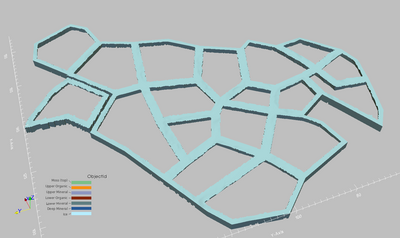 |
Mesh Input Parameters V3.C.1.1
General Description
Same as V03 using Polygons ## 6, 8, 9, 19, 21, 25, 27, 29, 31, 34, 35, 36, 37, 39, 45, 47, 50, 56. The only change was in the mesh_adjoin.py file in set_poly_surf_file. I added loop to break up the number of polygons to separate them with "&" in order to fix the "long line" error in lagrit. This version uses the following layer definitions :
- Layer 1 (top) is the live organic layer and should be 2 cm thick with 2 cells.
- Organic layer such that all combined are 48 cm thick with 24 cells (2cm each).
- Top organic and mineral layer are the same. Thickness is 18 cm with 9 cells.
- Lowest organic layer is about 3/4 the thickness of upper 2 layers. Set thickness to 12 cm with 6 cells.
- The bottom Materials 5 and 6 are both mineral soils with higher resolution at the top of the mineral soil.
- The domain bottom should be flat at Z = -1.
Material Ice Wedge
We want the top of the ice wedge to be at 50 cm depth (corresponds to the top of the inorganic layer).
Top of wedge starts at top of mineral layer (replaces cells only in materials 5 and 6)
Top wedge width (distance from polygon) is aprox 1.2
Depth from top of ice to tip is aprox 2.8
Outside Boundaries (Exodus side sets)
The side sets defined are top, bottom, and sides (corresponding to the 4 sectors within 45 degrees of each direction).
Output Mesh Description
Output is a stacked prism mesh written as two Exodus files; a single material mesh and a multi-material Mesh with 7 materials (6 layers plus the Ice Wedge).
Files are written in formats; Exodus II (.exo), AVS (.inp), and GMV (.gmv)
Final Mesh files: mesh_fsets.exo, mesh_fsets.gmv, mesh_fsets.inp
Final Mesh with single material: mesh_fsets_1mat.exo, mesh_fsets_1mat.gmv, mesh_fsets_1mat.inp
Mesh Element Type: prism
Mesh Software Used: LaGriT, ExodusII
Total nodes: 5622993
Total elements: 11034624
Total Volume: 0.3873006E+05
from file write_exo.out.txt:
Mesh Extents (Meters):
MIN MAX DIFFERENCE
x 7.933999634E+01 1.909821930E+02 1.116421967E+02
y 4.647000122E+01 1.706046448E+02 1.241346436E+02
z -1.000000000E+00 4.908469200E+00 5.908469200E+00
from file write_exo.out.txt:
SUMMARY VOLUME/AREA METERS of ELEMENT COLORS (BLOCKS)
Color Num. Elements Volume Fractional Volume
1 229888 0.1391476E+03 0.003592755
2 1034496 0.1252329E+04 0.032334795
3 1034496 0.1252332E+04 0.032334881
4 689664 0.8348857E+03 0.021556530
5 1686367 0.2512783E+04 0.064879402
6 5323696 0.2932920E+05 0.757272174
30 1036017 0.3409386E+04 0.088029463
from file stack_full_poly.out.txt:
SUMMARY ELEVATIONS at LAYER TOPS (METERS)
MIN MAX DIFF MAX below (thickness)
1 4.262400150 4.908469200 .02
2 4.242400150 4.888469200 .18
3 4.062400150 4.708469200 .18
4 3.882400150 4.528469200 .12
5 3.762400150 4.408469200 .50
6 3.262400150 3.908469200 4.99
(Bottom is flat at -1.0)
Mesh Layer Definitions (meters)
|
| ID |
Layer Name |
Layer
Thick |
Layer
Vertical Cells |
Layer
Volume |
Min Top
Elevation |
Max Top
Elevation |
| 1 |
moss(top) |
0.02 |
2 x .01 |
7.936425 |
4.50 |
4.99 |
| 2 |
upper organic |
0.18 |
9 x .02 |
79.36425 |
4.48 |
4.97 |
| 3 |
upper mineral |
0.18 |
9 x .02 |
71.42801 |
4.30 |
4.79 |
| 4 |
lower organic |
0.12 |
6 x .02 |
47.61855 |
4.12 |
4.61 |
| 5 |
lower mineral |
0.50 |
20 x .025 |
146.4469 |
4.00 |
4.49 |
| 6 |
deep mineral |
2.2 -
4.8 |
50 x .09 |
1745.817 |
3.50 |
3.99 |
| 7/30 |
ice |
0.00 -
2.3 |
variable |
182.7924 |
4.49 |
4.00 |
| 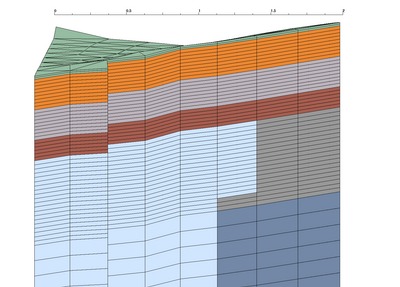 |
Boundary Side Sets
|
Top and Bottom:
neon-pink top (num_side_ss2) has 114944 faces
neon-green bottom (num_side_ss1) has 114944 faces
|
Sides:
red east right (num_side_ss3) has 26112 faces
yellow north back (num_side_ss4) has 30720 faces
green west left (num_side_ss5) has 18432 faces
blue south front (num_side_ss6) has 19968 faces
|
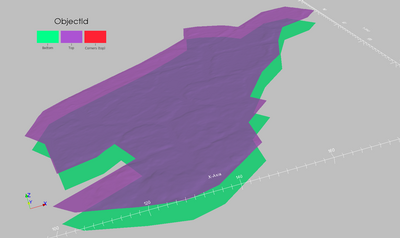 |
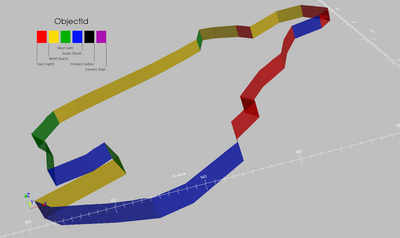 |
Project Archive Location
Full Set of files:
Download binary EXODUSII Format Mesh File: mesh_fsets.exo.gz (164M)
Download ASCII AVS Format Mesh File: mesh_fsets.inp.gz (362M)
Download binary GMV Format Mesh File: mesh_fsets.gmv.gz (208M)
File README.txt: README.txt
Mesh Work Directory: /scratch/sft2/lucia/grid_gen/arctic/arctic_fine_v3_C_1_1/
tar files created (not sent) (*tgz):
-rw-r--r-- 1 lucia sft 2653739829 Feb 26 17:02 mesh_v3_c_1_1.tgz
Created from clean subdirectories with mesh files:
drwxr-xr-x 3 lucia staff 4096 Feb 26 16:37 images
drwxr-xr-x 3 lucia sft 20480 Feb 26 16:50 v3_c_1_1
LaGriT faceset files with elem number and face (*.faceset):
-rw-r--r-- 1 lucia sft 1609319 Feb 26 16:44 fs_1_bot.faceset
-rw-r--r-- 1 lucia sft 1379431 Feb 26 16:44 fs_2_top.faceset
-rw-r--r-- 1 lucia sft 391783 Feb 26 16:44 fs_3_rig.faceset
-rw-r--r-- 1 lucia sft 460903 Feb 26 16:44 fs_4_bac.faceset
-rw-r--r-- 1 lucia sft 276583 Feb 26 16:44 fs_5_lef.faceset
-rw-r--r-- 1 lucia sft 299623 Feb 26 16:44 fs_6_fro.faceset
Mesh and faceset files for 6 Materials (mesh_fsets.*):
-rw-r--r-- 1 lucia sft 490665256 Feb 26 16:45 mesh_fsets.exo
-rw-r--r-- 1 lucia sft 840594560 Feb 26 16:45 mesh_fsets.gmv
-rw-r--r-- 1 lucia sft 1756152536 Feb 26 16:46 mesh_fsets.inp
Mesh and faceset files for 1 Material (mesh_fsets_1mat.*):
-rw-r--r-- 1 lucia sft 490663284 Feb 26 16:46 mesh_fsets_1mat.exo
-rw-r--r-- 1 lucia sft 770030032 Feb 26 16:46 mesh_fsets_1mat.gmv
-rw-r--r-- 1 lucia sft 1750529543 Feb 26 16:47 mesh_fsets_1mat.inp
LaGriT output files contain information reported during the run (*.out.txt):
-rw-r--r-- 1 lucia sftus 7992 Sep 26 16:05 get_poly_surf.out.txt
-rw-r--r-- 1 lucia sftus 22768 Sep 26 16:22 interpolate_icewedge.out.txt
-rw-r--r-- 1 lucia sftus 105831 Sep 26 16:05 make_poly10006.out.txt
-rw-r--r-- 1 lucia sftus 108585 Sep 26 16:05 make_poly10008.out.txt
. . .
-rw-r--r-- 1 lucia sftus 113607 Sep 26 16:11 make_poly10050.out.txt
-rw-r--r-- 1 lucia sftus 106305 Sep 26 16:11 make_poly10056.out.txt
-rw-r--r-- 1 lucia sftus 51520 Sep 26 16:11 merge_ice.out.txt
-rw-r--r-- 1 lucia sftus 269338 Sep 26 16:16 stack_full_poly.out.txt
-rw-r--r-- 1 lucia sftus 78740 Sep 26 16:41 write_exo.out.txt
Mesh images:
/scratch/sft2/lucia/grid_gen/arctic/arctic_fine_v3_C_1_1/images
Input Data files:
/scratch/sft2/lucia/grid_gen/arctic/arctic_fine_v3_C_1/input
-rw-r--r-- 2 lucia sftus 30928912 Jul 9 11:47 lidar_site3.inp
-rw-r--r-- 1 lucia sftus 123 Jul 9 11:47 poly10001.avs
-rw-r--r-- 1 lucia sftus 178 Jul 9 11:47 poly10002.avs
...
-rw-r--r-- 1 lucia sftus 155 Jul 9 11:47 poly10071.avs
-rw-r--r-- 1 lucia sftus 190 Jul 9 11:47 poly10072.avs
Main Work Directory for Polygon Meshing Method:
/scratch/sft2/lucia/grid_gen/arctic/arctic_fine_v3_C_1_1
Links to Images and Project Details
Gallery of All Project Images
Method Description Overview (from V01)
Input and Output Files Running LaGriT to create the Mesh
These are LaGriT input (.lgi) and output (outx3dgen) files used in creating this mesh. The output files provide good information about the data and mesh, including min and max values of mesh attributes.
The complete set of scripts and input files are in /scratch/sft2/lucia/grid_gen/arctic/arctic_fine_v3_C_1_1. The output files for various mesh versions are in /home/lucia/sandbox/arctic and /scratch/sft2/lucia/grid_gen/arctic/.
Steps to create the surface mesh for all polygons
To create a surface mesh, we run 2 python scripts. Normally, the Path 1 doesn't need to be re-run, so we just copy output files from this run to the output folder from the folder output_surf_mesh. If any of the Part 1 scripts are changed, then the Part 1 should be re-run, so Path 1 or 2 should be taken.
Path 1: Run script surf_mesh.py.
Path 2: (If you didn't run Part 1, remove all the files from the ouput folder. Then copy files from directory output_surf_mesh into the output folder.) Run script mesh_adjoin.py
Steps to create the 3D mesh for several polygons
The easiest path is to run surf_mesh.py and then mesh_adjoin.py scripts. That creates necessary LaGriT files and runs other scripts.
Step 1: Create Ice Objects from Polygon make_poly.lgi. This script is used to create all polygons separately. The Input is the same for all polygons. The output is different for all the polygons, but it is similar. To get the output for the polygon you are interested in, change the # of the polygon in the link: make_poly<enter_your_number>.out.txt
- Polygon #6: Output
Step 2: Merge all the ice objects created in Step 1. Input Output
Step 3: Create and stack layers into full mesh (stack_full_poly.lgi) Input Output
Step 4: Interpolate Ice Material on to Full Stacked Mesh (interpolate_icewedge.lgi) Input Output
Step 5: Create facesets and write final Exodus files (write_exo.lgi) Input Output
Grid Team Contacts
| Carl Gable |
<gable -at- lanl -dot- gov> |
505-665-3533 |
| Terry Miller |
<tamiller -at- lanl -dot- gov> |
505-667-8009 |
| Lucia Short |
<lucia -at- lanl -dot- gov> |
505-665-7957 |
